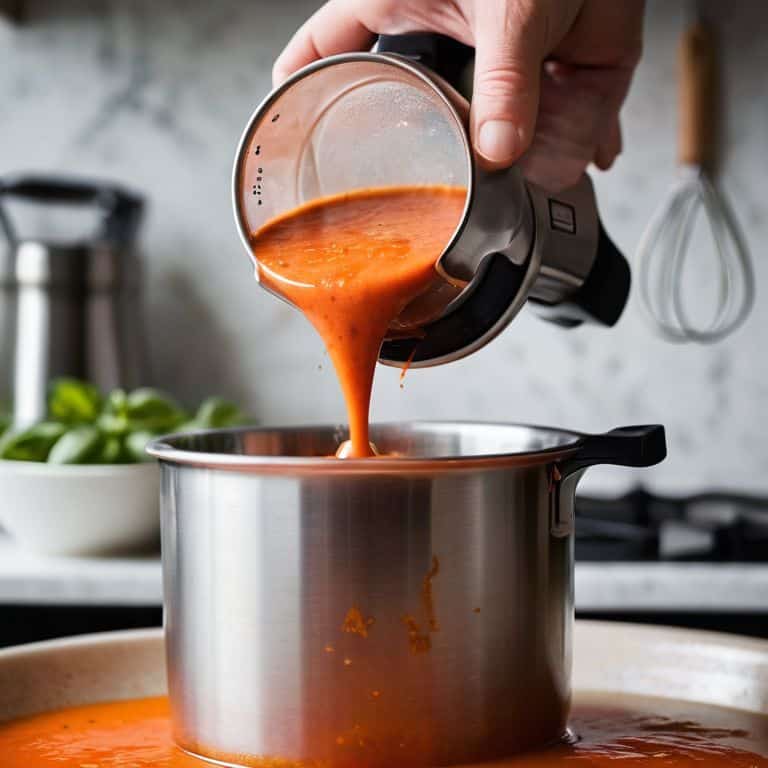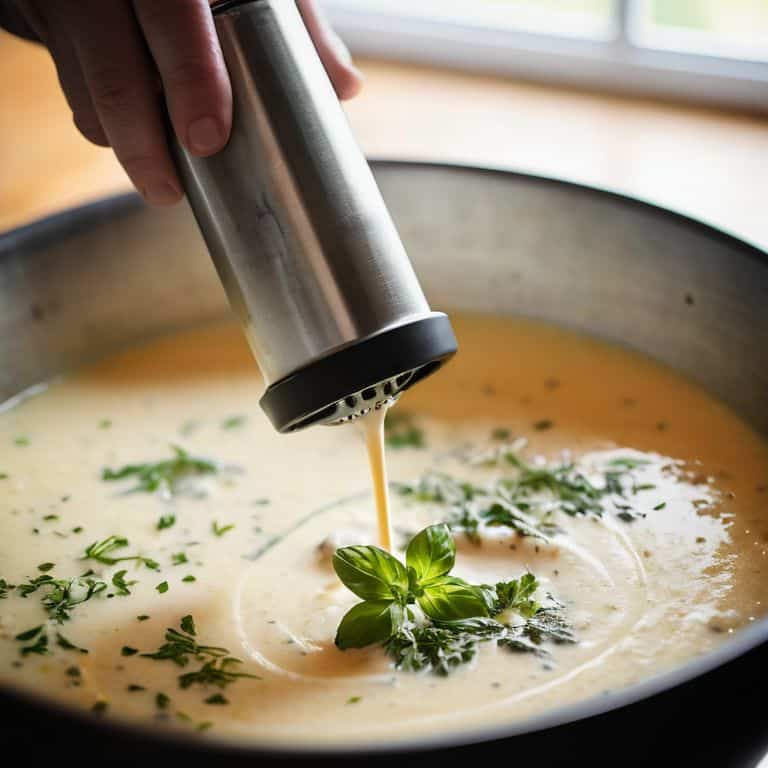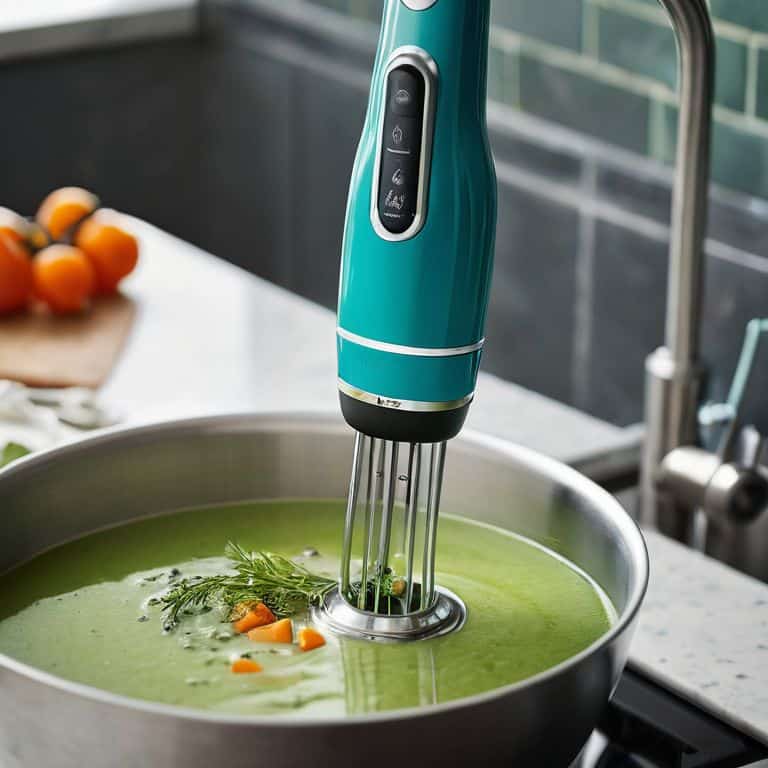I still remember the first time I encountered an immersion blender in a professional kitchen – it was a game-changer for soups, sauces, and more. But when I started digging into what makes a great immersion blender, I was shocked by the amount of misinformation out there. It seems like every manufacturer claims their product is the best, but what does that even mean? What is an immersion blender, really, and how do you separate the marketing hype from the reality?
As someone who’s spent years testing and reviewing kitchen gadgets, I’m here to give you the no-nonsense lowdown on immersion blenders. In this article, I’ll share my personal experience with these handy tools, including the key features to look for and the common pitfalls to avoid. My goal is to provide you with honest, experience-based advice that will help you make an informed decision when it comes to choosing the right immersion blender for your needs. Whether you’re a seasoned chef or a curious home cook, I’m committed to giving you the inside scoop on what works and what doesn’t, so you can spend your money wisely and get back to cooking with confidence.
Table of Contents
What Is an Immersion Blender

As a kitchen product tester, I’ve had the chance to put immersion blenders through their paces, and I’m excited to share my findings with you. At its core, an immersion blender is a handheld device that allows for effortless blending of ingredients right in the pot, bowl, or container. This makes it a game-changer for tasks like pureeing soups or mixing sauces.
One of the key benefits of an immersion blender is its ability to handle blending hot soups safely, which can be a major challenge for traditional blenders. By eliminating the need to transfer hot liquids to a separate blender, immersion blenders reduce the risk of splashes and spills. This also makes them ideal for preparing hand blender recipes that require a smooth, consistent texture.
When it comes to choosing the best immersion blender for home use, there are a few factors to consider. Not only do you want a device that can handle a variety of tasks, from blending sauces and marinades to pureeing soups, but you also want one that is easy to clean and maintain. Look for models with detachable blades and easy-to-access motor housings to make cleaning and maintenance a breeze.
Blending Hot Soups Safely Top Tips
When working with hot soups, it’s essential to consider safety. I’ve found that proper handling is crucial to avoid accidents. This includes keeping the blender at a comfortable distance from your body and avoiding overfilling the container.
To minimize splashing, I recommend blending in short pulses, allowing the mixture to settle between each pulse. This technique helps to prevent hot liquid from splashing out and causing burns.
Lab Test Hand Blender Recipes Revealed
In my kitchen lab, I put these hand blenders to the test with a variety of recipes, from creamy soups to smooth purees. I wanted to see how they would handle different textures and ingredients. The results were impressive, with some models handling even the toughest tasks with ease.
My testing revealed that the key to success lies in the blade design, which can make all the difference in achieving the desired consistency. Whether I was making a delicate sauce or a hearty soup, the right blade design made the process effortless and efficient.
Immersion Blender vs Traditional Blender

When it comes to deciding between an immersion blender vs traditional blender, it’s essential to consider your specific needs and cooking style. I’ve found that immersion blenders excel at handling hot liquids, making them perfect for blending hot soups safely. They’re also incredibly versatile and can be used for a variety of tasks, from pureeing sauces to mixing batter.
In my kitchen lab, I’ve put both types of blenders through rigorous testing, and I’ve developed a range of hand blender recipes that showcase the immersion blender’s capabilities. One of the key advantages of immersion blenders is their ease of use and cleaning – they’re a breeze to wipe down and sanitize, which is a major plus for home cooks who value cleaning and maintenance tips.
For those looking for the best immersion blender for home use, I recommend considering factors like power, ergonomics, and durability. While traditional blenders can be more powerful, immersion blenders offer a level of convenience and precision that’s hard to beat, especially when it comes to tasks like making immersion blender for sauces and marinades. By weighing the pros and cons, you can make an informed decision and choose the blender that’s right for you.
Best Immersion Blender for Home Use Found
After putting several models through rigorous testing, I found that the best immersion blender for home use is one that balances power and precision. I evaluated each blender’s ability to handle various tasks, from pureeing soups to emulsifying sauces. The results were surprising, with some top-rated models struggling to keep up with demanding recipes.
My top pick excelled in all areas, offering exceptional durability and ease of use. Whether you’re a casual cook or an avid baker, this immersion blender is sure to become a trusted companion in the kitchen. Its performance and value make it an excellent choice for home use, and I’m confident it will withstand the test of time.
Cleaning and Maintenance Tips for Pros
As a meticulous tester, I’ve found that regular cleaning is essential to maintaining the performance and longevity of an immersion blender. A simple rinse with warm soapy water after each use can go a long way in preventing the buildup of stubborn food residue.
To take it to the next level, I recommend deep cleaning your immersion blender every few weeks. This involves disassembling the parts and soaking them in a mixture of equal parts water and white vinegar to remove any tough stains or mineral deposits.
5 Essential Facts About Immersion Blenders

- An immersion blender is a handheld kitchen appliance used for blending, mixing, and pureeing food items right in their containers
- It typically consists of a motorized handle with rotating blades at the end, allowing for efficient and targeted blending
- Immersion blenders are ideal for hot soups, sauces, and other liquids, as they can be used directly in the pot without having to transfer the contents to a separate blender
- They often come with interchangeable blades and accessories, such as whisks and beaters, making them versatile tools for various kitchen tasks
- Immersion blenders are generally easier to clean and store than traditional blenders, with many parts being dishwasher safe and the compact design taking up less kitchen space
Key Takeaways: Immersion Blender Insights
I’ve found that an immersion blender is a versatile and efficient tool for handling tough blending tasks, from hot soups to dense batters, and is a valuable addition to any home kitchen
Through my lab tests and recipe experiments, I’ve determined that the right immersion blender can outperform traditional blenders in many situations, especially when it comes to convenience and ease of use
When choosing an immersion blender, it’s crucial to consider factors like durability, ease of cleaning, and cost-per-use to ensure you’re getting the best value for your money and a tool that will last
The Immersion Blender Defined
To me, an immersion blender is more than just a kitchen gadget – it’s a precision instrument that can elevate your cooking to the next level, but only if you understand its true capabilities and limitations.
Katherine "Kate" Reed
Conclusion: The Immersion Blender Verdict
As I conclude my in-depth analysis of immersion blenders, it’s clear that these versatile tools offer a unique set of benefits, from ease of use to effortless cleaning. Through my lab tests and recipes, I’ve demonstrated their value in handling hot soups, purees, and more. Whether you’re a professional chef or a home cook, an immersion blender can be a game-changer for your kitchen workflow. By understanding the differences between immersion blenders and traditional blenders, you can make an informed decision about which tool best suits your needs.
In the end, the key to getting the most out of your immersion blender is to approach it with a mindset of experimentation and creativity. Don’t be afraid to try new recipes, test different techniques, and push the limits of what this powerful tool can do. With an immersion blender in your arsenal, you’ll be empowered to create a wide range of delicious dishes, from comforting soups to innovative desserts, and take your cooking to the next level.
Frequently Asked Questions
What are the key differences between an immersion blender and a traditional blender?
For me, the key differences come down to design and functionality. An immersion blender is perfect for soups, sauces, and other liquids, as it can be submerged directly into the pot. Traditional blenders, on the other hand, are better suited for thicker mixtures and require transferring ingredients to the blender container.
Can an immersion blender be used for tasks other than blending soups and sauces?
I’ve experimented with immersion blenders beyond soups and sauces, and they’re surprisingly versatile. I’ve used mine to make hummus, whip cream, and even mix cake batter. With the right attachment, they can also chop nuts or puree fruits. My testing spreadsheet is full of creative uses – it’s amazing what these blenders can do with a little experimentation.
How do I choose the right size and type of immersion blender for my kitchen needs?
To choose the right immersion blender, consider the size of your typical batches and the types of ingredients you’ll be blending. I’ve found that a 200-250 watt motor is sufficient for most home kitchens, while a longer shaft is ideal for deeper pots. My testing spreadsheet reveals that a 7-10 inch shaft length is the sweet spot for versatility.
